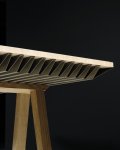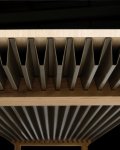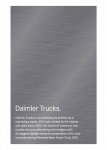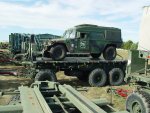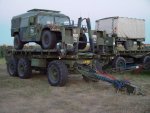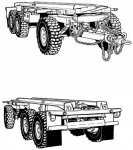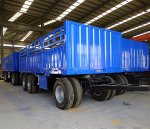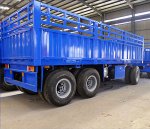.
CONTINUED FROM PREVIOUS POST
**************************************************
3. Air-Conditioning and an "Outdoorsy" Lifestyle are Completely Compatible
**************************************************
As for "interactivity", I am deliberately designing the TerraLiner to be
massively interactive with the outside. Sure, I want there to be lots of glass, just like a skoolie-bus conversion, so that when the owners are inside, they can still see outside. I very strongly dislike the claustrophobic feeling of most expedition campers that have tiny windows.
But in addition, I am designing the TerraLiner with large drop-down decks. Rob Grey's
Wothahellizat, for instance, strikes me as
the most outside-interactive motorhome ever built, because it has such a huge rear porch, where people can come and visit. I stated at the very beginning of the thread that the TerraLiner's having big porch areas would be very important, precisely because I don't want the TerraLiner to be the hermetically sealed capsule that most motorhomes are by default. Most motorhomes have just one entrance up front, it's just a tiny door that one person can go through, and that's it. If you examine again everything that I've written on this topic, and all the images that I have shown which indicated where I want to go in terms of TerraLiner design, you'll see that I have always been intensely conscious of designing the TerraLiner for maximum outside interactivity.
Perhaps because I've spent so much time in Florida, I simply do not accept the idea that constantly transitioning from hot outside to cool inside makes one sick. That's literally what I did every day, day-in day-out, when I spent vacations in Florida. In the summer I would just wear a bathing suit all day, nothing more, and I would be constantly moving from cool air inside an Air-conditioned house, to hot air outside where I would bicycle; take the boat out for fishing, waterskiing, windsurfing, and scuba-diving; check out the girls at the hotel's pool on the island, and so on.
egn, literally
millions of Americans do exactly the same thing in America's deep south, or during the summer months in America's north. They constantly move from Air-Conditioined interiors that are cool, to outsides that are hot. Yes, I know that Europeans -- Germans especially -- have a deeply held belief that this sort of lifestyle is "un-natural" and "un-healthy". But just because most Germans believe something, does not necessarily make it true. And in tropical countries that are becoming rich, local people are "voting" with their money to follow the American example, not the German one. In rich tropical and sub-tropical cities like Hong Kong and Singapore, Air-Conditioning is strongly preferred.
I also hear that in Australia, Air-Conditioning has become very popular too, almost as popular as it is in the United States. But nobody would ever accuse Australians of being an "indoor" sort of people. Like Floridians, Australians are very "outdoorsy". But like Floridians, Australians also love their Air-Conditioning. Three out of four Australian households now have Air-Conditioning, i.e. 75 %. The figure for the United States is 87 % of households -- see
http://www.ausgrid.com.au/Common/Ab...nth=1&id=5dc6b7ee-56b3-4a69-bb6a-46352d18564f and
http://www.citylab.com/cityfixer/20...used-much-air-conditioning-americans-do/6498/ . Whereas in Europe only 2 % of German households have Air-Conditioning; 5 % of French households; but 99 % of Greek households, surpassing even the United States -- see
http://www.seattletimes.com/nation-...of-europe-still-cool-toward-air-conditioning/ . Here again I can't help but think that geography and climate explains the difference, because Germany never gets as consistently super-hot as Greece does during the summer months.
I guess when it comes to TerraLiner design I should resign myself to the fact that some people have strong anti-Air-Conditioning prejudices, i..e those who are northern European, and Germans in particular. But I can't design the TerraLiner just to suit German anti-Air-Conditioning preferences. The TerraLiner has to be designed also to serve wealthy retired people who are not German; and such people tend to be more American in their attitudes towards Air-Conditioning, than German. Read the articles that I referenced, and you may come to realize that your anti-Air-Conditioning prejudice is deeply, profoundly German. And you will also learn that it's a prejudice that that millions of non-Germans simply do not share.
So I see no reason whatsoever why the TerraLiner can't be both an Air-Conditoined vehicle, and simultaneously a very "social" vehicle that is open to the outdoors, and to other campers. I just don't see the same dualisms that you seem to see,
egn, because I grew up living a very "outdoorsy", active lifestyle during my vacations in the Florida Keys, a lifestyle where at night I slept in an Air-Conditioned vacation home. Remember, I have personally caught and filleted thousands of fish, and I still have a mark on my forearm where I once got a sun-blister because I was out on the water too long.
The "two philosophies" dichotomy, I might suggest, is something that resides in the minds of those who are militantly against Air-Conditioning. It is a dichotomy that exists in the heads of Germans. But it's not a real dichotomy, and it's not a universally shared dichotomy. It's a culturally constructed fiction, and it is a dichotomy that does not have to exist.
**************************************************
4. Reducing the TerraLiner's Heat-Gain: An Awning-Shaded Greenhouse
**************************************************
There is no question that
everything about the TerraLiner's camper shell needs to be designed for maximum energy efficiency. For instance, I would like to know whether triple-glazed windows for motorhomes exist. Double-glazed windows for motorhomes exist, but in residential construction, triple-glazed windows are now virtually standard in Canada, because they insulate so well against both cold and heat. The TerraLiner's windows will also have smart glass, so that they can go instantly opaque; and they will have built-in roll-down thermal blinds, to add yet more insulating capability.
The technical description for all of this is
"reducing the RV's heat gain". Here is an interesting exploration of some aspects of RV Air-Conditioning courtesy of "
Ask the Professor"; skip ahead 4 minutes 20 seconds into the video:
One thing that struck me in particular, is a very simple, dead-obvious, low-tech idea: that massive
awnings will considerably reduce the TerraLiner's heat-gain. Instead of the sun hitting the side walls of the TerraLiner directly, the sun will hit the awnings, and the TerraLiner's side-walls will then be effectively in shade. This incidentally, is one of the reasons why old homes in the American south have such huge porches: so that the sun does not hit the sides of the house directly. So yes, the TerraLiner will have lots of windows, but lots of windows does not automatically mean "greenhouse" and "massive heat gain". Old homes in the American south also have lots of big windows, but their ground floors remain cool inside because of their huge porches.
This is also, sort of, the principle behind a "tropical roof", which we've already discussed; see post #138 at
http://www.expeditionportal.com/for...w-6x6-Hybrid-Drivetrain?p=1569156#post1569156 .
I find it interesting that my "natural" inclination right from the beginning was to want the TerraLiner to be surrounded by as much awning and as much deck-surface as possible. Again, this is probably because as a kid I spent vacations in the Florida Keys, and sometimes at a cottage in northern Ontario. In both places the central socializing space was always the porch or terrace, and in Florida, large terraces are typically equipped with retractible awnings. So my natural inclination right from the start has been to want to design the TerraLiner to be much more like a cottage or Florida vacation home, with big drop-down decks and awnings.
This then led naturally enough to the idea of using the awnings as surfaces for more solar cells, of the thin-film flexible kind. And as I thought things through, I realized that drop-down side-decks could serve as rock-solid supports for a truly strong pergola-awning system that can withstand high wind-speeds. My main motivation here became enabling the thin-film flexible solar cells in the awnings to remain deployed for as long as possible. But as it turns out, there will be the added advantage that as long as the awnings are deployed, the "solar heat gain" on the side-walls of the TerraLiner will be significantly reduced. Advance ahead 7 minutes 5 seconds into the video for the discussion of awnings.
So put it this way: I have already been designing in a very sophisticated way to reduce heat-gain, while allowing the TerraLiner to still have large windows. Yes, when "unfolded" the TerraLiner will be a bit of a greenhouse, with lots of windows. But it will be an
awning-
shaded greenhouse.....:sombrero:
Agreed that the Air-Conditioning units installed will have to be the most efficient available. According to the
technomadia website, the most efficient current Air-Conditioners are two-piece "mini split" systems, which are different than the Air-Conditioners usually installed in motorhomes -- see
http://energy.gov/energysaver/ductless-mini-split-air-conditioners and
https://en.wikipedia.org/wiki/Air_conditioning#Split_systems . I haven't researched motorhome Air-Conditioners yet, so I don't know if this claim is true or not. For some interesting initial thoughts, see the ExPo thread at
http://www.expeditionportal.com/for...tually-install-mini-split-heat-pump-on-camper , and also see
http://sprinter-source.com/forum/showthread.php?t=21837 and
http://www.fiberglassrv.com/forums/f56/using-a-mini-split-a-c-heat-pump-on-your-unit-58009.html . The most important thing seemed to be to first develop a very "rough ball-park" guesstimate of what the TerraLiner's peak Air-Conditioning power needs might be, based on analogies to households in the American south, or other RV's like the Class-A tested by
technomadia. And this whole line of discussion came up, of course, because I have been trying to guesstimate the most appropriate size of the TerraLiner's battery pack.
Once we begin to discuss Air-Conditioning at length from a technological point of view, things will probably get very detailed and technical. For instance, some will claim that the best that Air-Conditioners can do is reduce the temperature inside a motorhome by 20 degrees Fahrenheit relative to the temperature outside, because Air-Conditioners have to "suck in" hot air from the outside. If the air outside has a Heat Index (temperature + humidity) of 110, then the "best" that an Air-Conditoiner can supposedly do is 90 degrees Fahrenheit inside. I've seen this claim repeated more than once on various RV websites, where the assumption seems to be that RV Air-Conditioners draw their air from outside. But this is false: RV Air-Conditioners recycle interior air, and there is no reason why an RV Air-Conditioner could not achieve the optimum 75 degrees interior temperature, even if outside the Heat Index is 120 -- see
http://bryantrv.com/roofac.html :

The main issue regarding the outside temperature is overall camper-body heat gain, not sucking in hot air. So awnings will prove very useful. But so too, needless to say, adequate insulation will be very important, and triple-glazed windows (if available), so that no matter what the temperature is outside, the interior remains relatively "immune".
RV air-conditioners also seem to be different from residential air-conditioners in important ways, although I am still not clear what all those ways are. And then there is a debate about whether "Basement A/C" is better than "Rooftop A/C", with no conclusive arguments on either side -- see the discussion at
https://www.rv.net/forum/Index.cfm/fuseaction/thread/tid/26042560/print/true.cfm .
**************************************************
5. Why Glamping on Farmland is not an Illusion
**************************************************
TerraLiner glamping on a farmer's field may or may not be an illusion. Only experience will prove things one way or the other.
But there is no question that many farmers are already actively encouraging motorhomes to camp on their land, as a way to earn extra income. Surely you are familiar with the French concept of
"Camping à la Ferme"? See
http://about-france.com/tourism/camping.htm and
Camping à la Ferme .
[video=youtube;rJLNe0AAza4]https://www.youtube.com/watch?v=rJLNe0AAza4 [/video]
In North America, there is even an organization called "
Harvest Hosts", which pre-arranges for RVs to
"dry camp" on farms -- see
https://harvesthosts.com . The emphasis is on one night for free (!!), but the mere fact that such a network exists, suggests that you are wrong in thinking that farmers do not want motorhomes to camp on their land. My own sense is that the exact opposite would be nearer the truth, especially if a motorhome were willing to pay a monthly rent, and stay for an extended period. Farming is a difficult business, margins are thin, and most independent farmers have to hold down various odd jobs in addition to farming, in order to make ends meet. They can't live off farming alone. Which his why in Italy so many farms have become
"agriturismi".
But as
Harvest Hosts suggests, farmers are only interesting in having RVs stay on their land if they dry camp. No hookups, no services for disposing of greywater or blackwater, and no shore electricity. That is precisely why I have been spending so much time thinking about all the ways to make the TerraLiner completely autonomous. For instance, an incinerating toilet to dispose of sewage. Rooftop rainwater collection, AWGs, and a watermaker to independently produce water. Massive solar and a big battery bank, so that the generator will need to run less often, and fuel for glamping can be extended much further.
From the point of view of physical space, nothing could be better for a TerraLiner than glamping on a farm. Unlike RV parks, farms that want to host motorhomes for "dry camping" will not have pre-prepared, dedicated pitches of certain set sizes. If one telephones ahead, and explains the size of one's class-A vehicle, then I am certain that the kind of farmer who wants to be a "Harvest Host" would have no problem finding room for the TerraLiner. However, because the TerraLiner would in effect be extending a new kind of tourism that was first developed in France to the rest of the world, it's quite possible that outside of developed world the TerraLiner would need to enlist the services of specialized travel agents to pre-book its long-stay glampsites. These would be travel agents that specialize in rural tourism. They do exist, and I know that Italy is full of such travel agents, because Italy has so many
agriturismi. Or one might need to enlist the services of a single provider like
Audley Travel in the UK, which is specialized in creating tailor-made "adventure" holidays that have unusual itineraries -- see
http://www.audleytravel.com/?audcmp...vel&auddev=c&gclid=CLfNhaX79skCFVCZGwodLqgEDw . Asking Audley to research
"Camping à la Ferme" glampsites across the globe for extended stays would be a bit unusual, but Audley is a company that is habituated to unusual requests.
So I simply disagree with you about glamping on farmland. Just because it hasn't been done extensively outside of France, does not mean that it's not possible. If I have time, later in the thread I'll do a series of posts in which I show how the TerraLiner might island-hop across the Caribbean. Yes, it can be done, because there do exist RORO vessels that can take the TerraLiner all the way from Miami to Trinidad, by way of the Dominican Republic, Puerto Rico, the U.S. and British Virgins, and the French Islands. And I'll show how on large islands like the Dominican Republic, it is in fact possible to find "Eco-Lodges" and "Organic Farms" that would welcome a dry-camping motorhome, even though they have no facilities or paved pitches for more formal RV camping of the kind where there's provision of shore-power, sewage hookups, etc. I researched the Caribbean in particular because I already know it reasonably well, and it seems like a relatively "demanding" context for the TerraLiner to travel. If the TerraLiner could find excellent glampsites in the Caribbean, then it could find them anywhere.
**************************************************
CONTINUED IN NEXT POST.

















